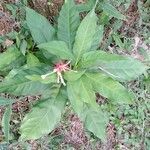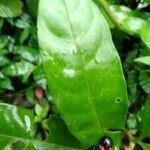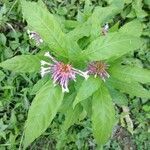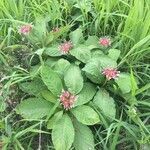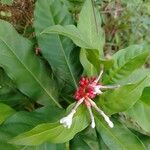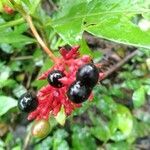Shrub 0.3-1.5 m high, unbranched or rarely branched. Branches 0.3-0.4 cm diam., rather densely lenticellate; branchlets glabrous. Leaves confined to the apex of the branchlets, in whorls of 3 or 4 (or 5), very rarely opposite; petiole 0.3-2.4(-3) cm long, glabrous; blade papery, ovate, elliptic or obovate, 5-19.5 by 1.6-7.3 cm, 1.7-4.6 times as long as wide, apex acuminate to slightly obtuse, base cuneate to slightly decurrent, glabrous above and beneath; secondary veins 5-10 pairs, 0.4-3.3 cm spaced, arcuate-ascending, forming an angle of 45-50(-60)° with the midrib, often rather straight at base. Inflorescence 3.8-9(-14.1) cm long, terminal cymes, sometimes also axillary, usually solitary, congested, 20-more than 35-flowered; peduncle 2.6-9.6 by 0.1-0.2 cm; pedicels 0.1-0.4 cm long, glabrous. Sepals narrowly ovate, 1.3-3.5 by 0.4-0.8 mm, 3.2-4.8 times as long as wide, apex acute, glabrous. Corolla white or rather pinkish, 8-16 mm long in the mature bud and forming an ovoid head of 1.5-2.9 by 1-2 mm, glabrous outside, with 2 belts of indumentum inside around the insertion of the stamens and below the mouth and up to the mouth; tube 9-18 mm long, 3-6.9 times as long as calyx, 3.6-6 times as long as lobes, slightly twisted; lobes obliquely ovate, 2-3 by 1.2-2.1 mm, 1.3-1.8 times as long as wide, obtuse or rarely retuse. Stamens inserted at 7.5-12 mm from base, 0.6-0.8 of tube length; filaments 0.8-1 mm long; anthers 1.1-1.5 by 0.3-0.4 mm, 2.5-4.5 times as long as wide. Disk cup-shaped, 0.8-1 by 0.6-1 mm, 0.45-0.65 times as long as ovary, slightly crenate. Pistil mostly glabrous; ovary ovoid, 1.3-1.9 mm long, consisting of 2 carpels which are connate at the base; style filiform, 6.2-9.1 mm long; style head 0.5-0.6 mm long. Fruit black to reddish black when mature, syncarpous, cordate, mericarps connate at the base for 3-4 mm, or 0.55-0.65 of their length, sometimes only 1 carpel developing; each mericarp obliquely ovoid or subglobose, 5-6 by 4-4.5 mm, 1.2-1.3 times as long as wide, apex obtuse. Seeds 1 in each half, obliquely ovoid, 3-4 by 2.2-3 mm, 1.2-1.4 times as long as wide, acute, glabrous.
More
Shrubs to 1 m tall, erect, glabrous. Stems usually unbranched, slender, straw colored. Leaves grouped near stem apex, in whorls of 3-5; petiole 1-1.5 cm; leaf blade narrowly elliptic or obovate, membranous, 7-17 X 2-9 cm, base cuneate, apex acuminate or rarely obtuse; lateral veins 7-15 pairs. Cymes congested; peduncle 5-13 cm, red or reddish. Pedicel and calyx red or reddish. Corolla white, tube cylindric, 1-1.8 cm, inflated at middle and pilose inside distal half; lobes obliquely suborbicular, 1.5-3.5 mm. Stamens inserted at middle of corolla tube. Ovaries connate in basal half. Drupes ellipsoid, ca. 8 mm, connate for half their length. Fl. Feb-Oct, fr. May-Dec. 2n = 22.
A small shrub. It grows 1 m tall. The stems are usually unbranched and slender and straw coloured. The leaves are grouped near the tip of the stem. They are in rings of 3-5. The leaves are narrowly oval and 7-17 cm long by 2-9 cm wide. The base is wedge shaped and they taper to the tip. The flowers are tube shaped and white. The fruit are oval and 8 mm across.
UsesMost of the uses described in the introductory chapters for Rauvolfia as a whole apply to this species. These include the treatment of snake bites, mental illnesses and epilepsy. In other areas it has been used as a treatment for high blood pressure, for a wide range of mental health problems, liver diseases, dysentery and in childbirth. It has also been used externally for eye problems and as a treatment for wounds.
More
The root is used as medicine.
